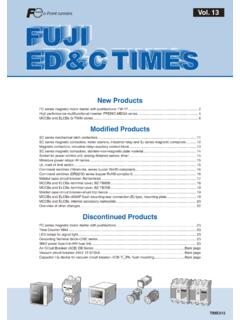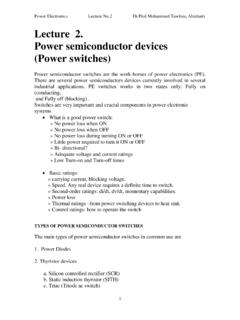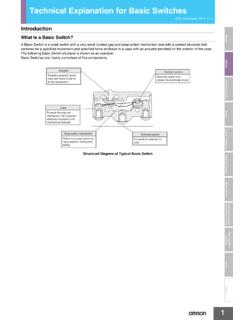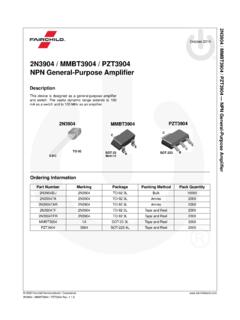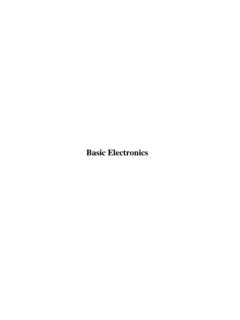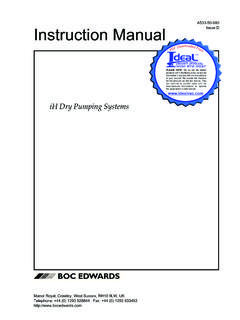Transcription of Chapter 7 Gate Drive circuit Design - Fuji Electric
1 Chapter 7 Gate Drive circuit Design 7-1 CONTENTS Page 1 IGBT Drive conditions and main characteristics .. 7-2 2 Drive current .. 7-5 3 Setting dead-time .. 7-7 4 Concrete examples of Drive circuits .. 7-9 5 Drive circuit setting and actual implementation .. 7- 10 This section explains the Drive circuit Design . In order to maximaize the performance of an IGBT, it is important to properly set the Drive circuit constants Chapter 7 Gate Drive circuit Design 7-2 1 IGBT Drive conditions and main characteristics IGBT Drive conditions and main characteristics are shown below. An IGBT s main characteristics change according to the values of VGE and RG, so it is important to use settings appropriate for the intended use of the equipment in which it will be installed.
2 Table 7-1 IGBT Drive conditions and main characteristics Main characteristics +VGE rise VGE rise RG ON rise RG(oFF) rise VCE(sat) Fall - - - ton Eon Fall - Rise - toff Eoff - Fall Rise Rise Turn-on surge voltage Rise - Fall - Turn-off surge voltage - Rise - Fall *1 dv/dt malfunction Rise Fall Fall Fall Current limit value Rise - - - Short circuit withstand capability Fall - - - Radiational EMI noise Rise - Fall Fall *1: Dependence of surge voltage on gate resistance is different for each series 1. 1 +VGE (On state) A recommended the gate on state voltage value (+ VGE) is +15V. Notes when + VGE is designed are shown as follows. (1) Set +VGE so that is remains under the maximum rated G-E voltage, VGES = 20V. (2) It is recommended that supply voltage fluctuations are kept to within 10%.
3 (3) The on-state C-E saturation voltage VGE(sat) is inversely dependent on +VGE, so the greater the +VGE the smaller the VGE(sat). (4) Turn-on switching time and switching loss grow smaller as +VGE rises. (5) At turn-on (at FWD reverse recovery), the higher the +VGE the greater the likelihood of surge voltages in opposing arms. (6) Even while the IGBT is in the off-state, there may be malfunctions caused by the dv/dt of the FWD s reverse recovery and a pulse collector current may cause unnecessary heat generation. This phenomenon is called a dv/dt shoot through and becomes more likely to occur as +VGE rises. (7) In V and U series IGBTs, the higher the +VGE, the higher the current limit becomes. (8) The greater the +VGE the smaller the short circuit withstand capability.
4 Chapter 7 Gate Drive circuit Design 7-3 IGBT1 IGBT2 FWD2 FWD1 RgRgOff stateI=Cres xdV/dtIGBT1 IGBT2 FWD2 FWD1 RgRgOff stateI=Cres xdV/dt Principle of unexpected turn-on 1. 2 -VGE (Off state) A recommended the gate reverse bias voltage value (-VGE) is 5 to -15V. Notes when -VGE is designed are shown as follows. (1) Set -VGE so that it remains under the maximum rated G-E voltage, VGES = 20V . (2) It is recommended that supply voltage fluctuations are kept to within 10%. (3) IGBT turn-off characteristics are heavily dependent on -VGE, especially when the collector current is just beginning to switch off. Consequently, the greater the -VGE the shorter, the switching time and the switching loss become smaller. (4) If the -VGE is too small, dv/dt shoot through currents may occur, so at least set it to a value greater than 5V.
5 If the gate wiring is long, then it is especially important to pay attention to this. 1. 3 RG (Gate resistance) Gate resistance RG listed in the product specification sheets is the value on the condition so as to decrease the switching losses. So, you must select the optimal RG according to the circuit or operating condition. Notes when RG is designed are shown as follows. (1) The switching characteristics of both turn-on and turn-off are dependent on the value of RG, and therefore the greater the RG the longer the longer the switching time and the greater the switching loss. Also, as RG increases, the surge voltage during switching becomes smaller. (2) The greater the RG the more unlikely a dv/dt shoot through current becomes. (3) Various switching characteristics are varied for stray inductance.
6 Especially, spike voltages when IGBTs are turned off or FWDs are recovered reversibly are influenced on the stray inductance. Therefore, RG need to be designed on the lower stray inductance condition. Select the most suitable gate Drive conditions while paying attention to the above points of interdependence. 1. 4 avoid the unexpected turn-on by recovery dv/dt In this section, the way to avoid the unexpected IGBT turn-on by dv/dt at the FWD s reverse recovery will be described. shows the principle of unexpected turn-on caused by dv/dt at reverse recovery. In this figure, it is assumed that IGBT1 is turned off to on and gate to emitter voltage VGE of IGBT2 is negative biased. In this condition, when IGBT1 get turned on from off-state, FWD on its opposite arm, that is, reverse recovery of FWD2 is occurred.
7 At same time, voltage of IGBT2 and FWD2 with off-state is raised. This causes the dV/dt according to switching time of IGBT1. Because IGBT1 and 2 have the mirror capacitance CGC, Current is generated by dV/dt through CGC. This current is expressed by CGC x dV/dt. This current is flowed through the gate resistance RG, results in increasing the gate potential. So, VGE is generated between gate to emitter. If VGE is excess the sum of reverse biased Chapter 7 Gate Drive circuit Design 7-4 -VGEHigh-RG-VGEHigh-RG (a) additional Cge (b) increase of -Vge (c) increase of RG Fig. 7-2 Methods to avoid unexpected turn-on voltage and VGE(th), IGBT2 is turned on.
8 Once IGBT2 is turned on, the short- circuit condition is happened, because both IGBT1 and 2 is under turned-on state. From this principle, the methods to avoid the unexpected turn-on are shown in There are three methods, which are the CGE addition, increase of reverse bias voltage and increase of RG. The method to add the CGE is the way to the decrease of unexpected turn-on current by sharing to CGE. Sharing current charges and/or discharges the additional CGE. In order to charge and/or discharge the additional CGE, switching speed gets lower. Just only adding the CGE results in the increase switching losses. However, lower Rg adding CGE at the same time can control switching speed. In other words, both adding the CGE and decreasing the RG can avoid the unexpected turn-on without increasing switching losses.
9 Driving higher RG can decrease dV/dt, results in soft-switching. However, it has the disadvantage of increase switching losses as well. Moreover, although the method to enlarge the reverse bias is also effective to avoid the unexpected turn-on, the quantity of the gate charge becomes larger. From these viewpoints, adding the CGE is recommended to avoid unexpected turn-on. Recommended CGE is two times value on the specification sheet and Recommended RG is the half before adding CGE. In this case, you must confirm the various characteristics. Chapter 7 Gate Drive circuit Design 7-5 2 Drive current Since an IGBT has a MOS gate structure, to charge and discharge this gate when switching, it is necessary to make gate current ( Drive current) flow.
10 Shows the gate charge (dynamic input) characteristics. These gate charge dynamic input characteristics show the Electric load necessary to Drive the IGBT and are used to calculate values like average Drive voltage and the driving Electric power. shows the circuit schematic as well as the voltage and current waveforms. In principle, a Drive circuit has a forward bias power supply alternately switching back and forth using switch S1 and S2. During this switching, the current used to charge and discharge the gate, is the driven current. In Fig. 7-4, the area showing the current waveform (the hatched area) is equivalent to the gate charge from +Qg: Gate chargeQ(C)-VGE(V)+VGE(V)VGE(V)-Qg+Qg: Gate chargeQ(C)-VGE(V)+VGE(V)VGE(V)-Qg Fig. 7-3 Schematic waveform of gate charge characteristics (Dynamic input characteristics).







